service indicator Ram 1500 2016 User Guide
[x] Cancel search | Manufacturer: RAM, Model Year: 2016, Model line: 1500, Model: Ram 1500 2016Pages: 916, PDF Size: 7.55 MB
Page 793 of 916
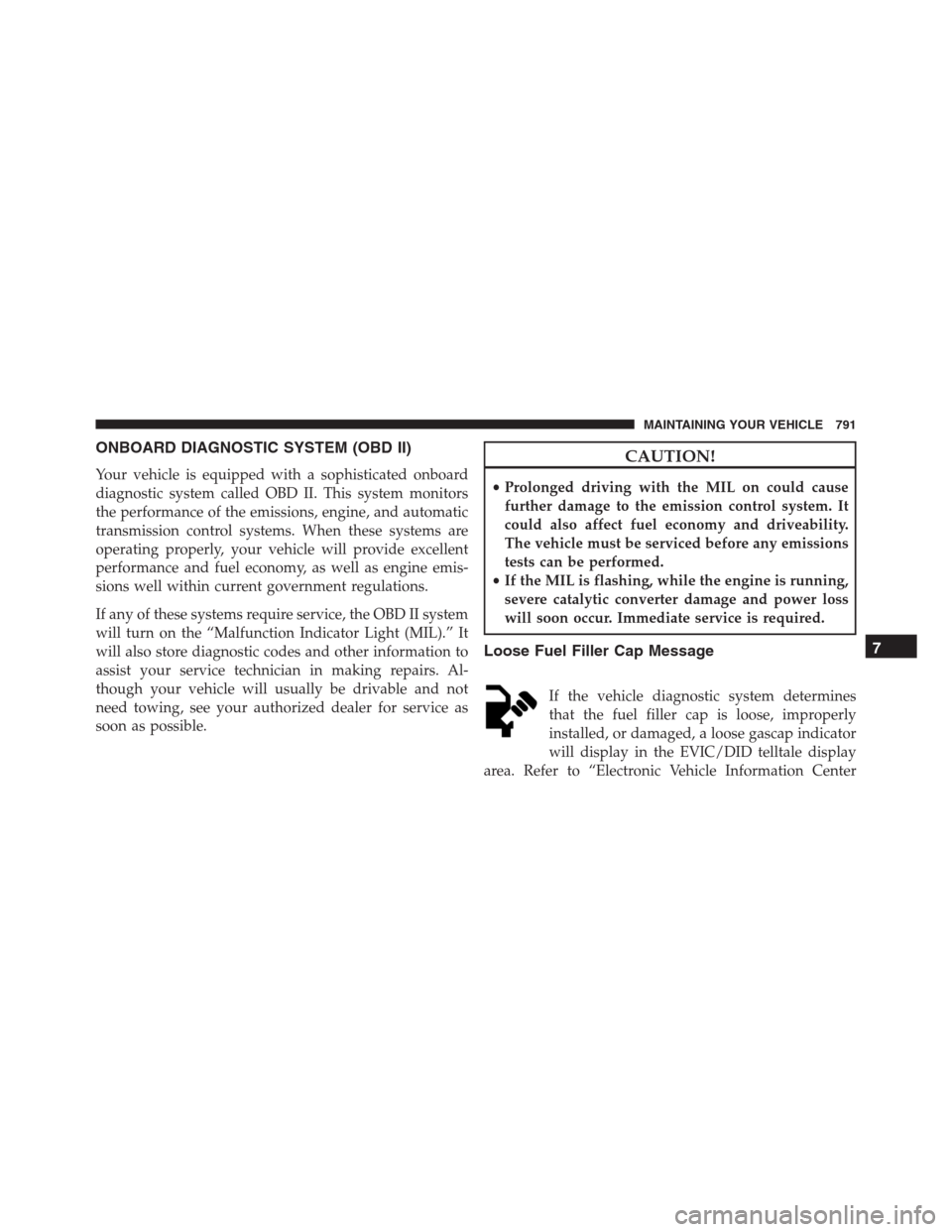
ONBOARD DIAGNOSTIC SYSTEM (OBD II)
Your vehicle is equipped with a sophisticated onboard
diagnostic system called OBD II. This system monitors
the performance of the emissions, engine, and automatic
transmission control systems. When these systems are
operating properly, your vehicle will provide excellent
performance and fuel economy, as well as engine emis-
sions well within current government regulations.
If any of these systems require service, the OBD II system
will turn on the “Malfunction Indicator Light (MIL).” It
will also store diagnostic codes and other information to
assist your service technician in making repairs. Al-
though your vehicle will usually be drivable and not
need towing, see your authorized dealer for service as
soon as possible.
CAUTION!
•Prolonged driving with the MIL on could cause
further damage to the emission control system. It
could also affect fuel economy and driveability.
The vehicle must be serviced before any emissions
tests can be performed.
•If the MIL is flashing, while the engine is running,
severe catalytic converter damage and power loss
will soon occur. Immediate service is required.
Loose Fuel Filler Cap Message
If the vehicle diagnostic system determines
that the fuel filler cap is loose, improperly
installed, or damaged, a loose gascap indicator
will display in the EVIC/DID telltale display
area. Refer to “Electronic Vehicle Information Center
7
MAINTAINING YOUR VEHICLE 791
Page 794 of 916
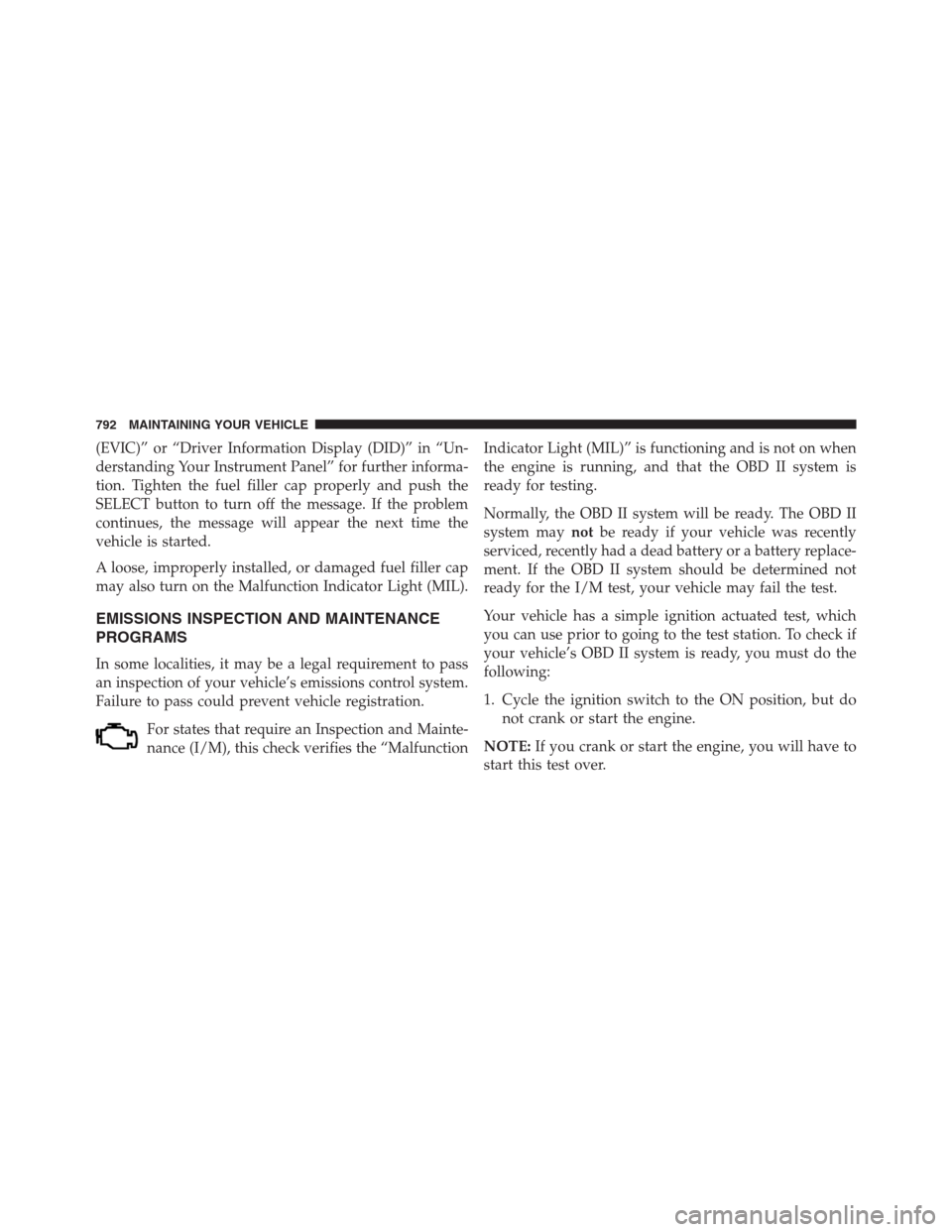
(EVIC)” or “Driver Information Display (DID)” in “Un-
derstanding Your Instrument Panel” for further informa-
tion. Tighten the fuel filler cap properly and push the
SELECT button to turn off the message. If the problem
continues, the message will appear the next time the
vehicle is started.
A loose, improperly installed, or damaged fuel filler cap
may also turn on the Malfunction Indicator Light (MIL).
EMISSIONS INSPECTION AND MAINTENANCE
PROGRAMS
In some localities, it may be a legal requirement to pass
an inspection of your vehicle’s emissions control system.
Failure to pass could prevent vehicle registration.
For states that require an Inspection and Mainte-
nance (I/M), this check verifies the “MalfunctionIndicator Light (MIL)” is functioning and is not on when
the engine is running, and that the OBD II system is
ready for testing.
Normally, the OBD II system will be ready. The OBD II
system maynotbe ready if your vehicle was recently
serviced, recently had a dead battery or a battery replace-
ment. If the OBD II system should be determined not
ready for the I/M test, your vehicle may fail the test.
Your vehicle has a simple ignition actuated test, which
you can use prior to going to the test station. To check if
your vehicle’s OBD II system is ready, you must do the
following:
1. Cycle the ignition switch to the ON position, but do
not crank or start the engine.
NOTE:If you crank or start the engine, you will have to
start this test over.
792 MAINTAINING YOUR VEHICLE
Page 795 of 916
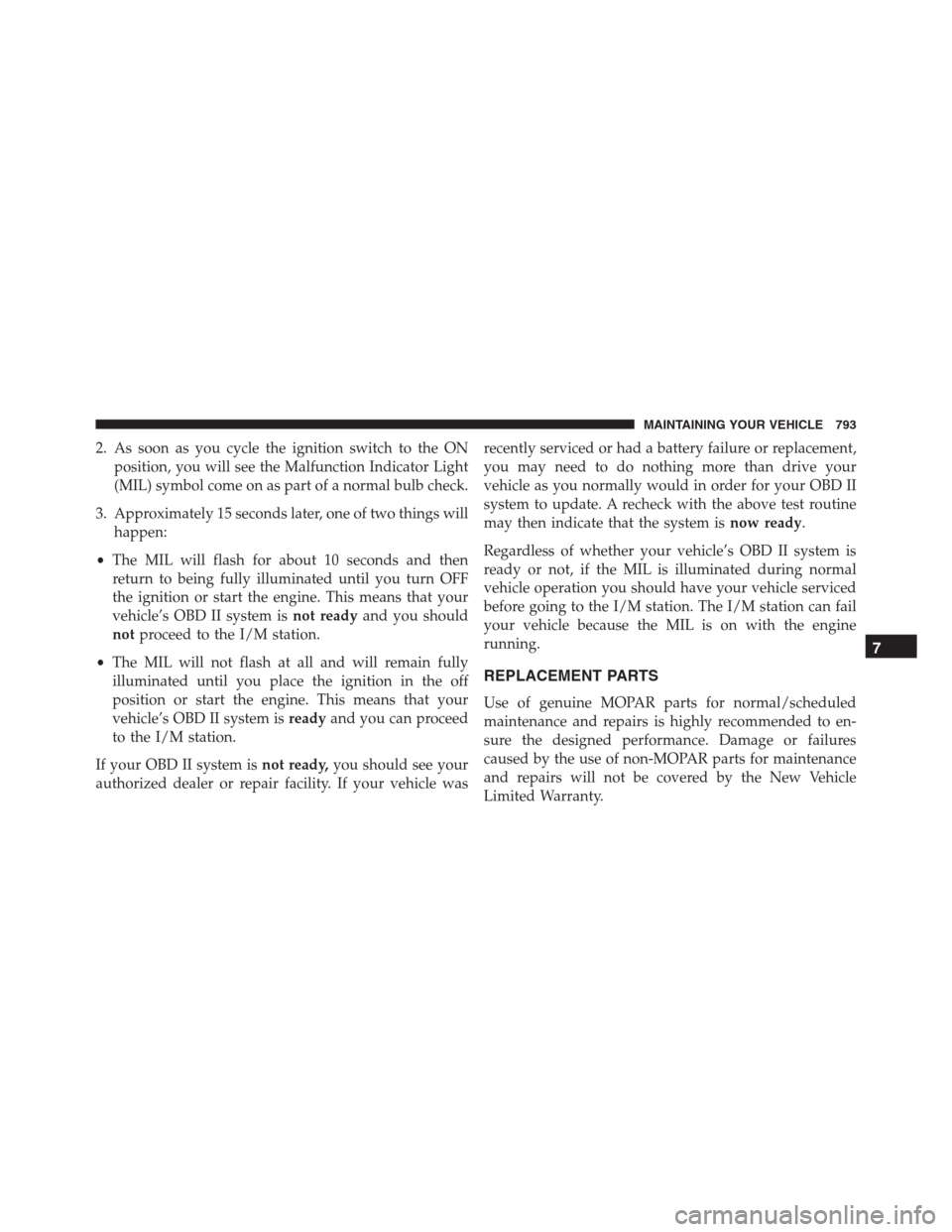
2. As soon as you cycle the ignition switch to the ON
position, you will see the Malfunction Indicator Light
(MIL) symbol come on as part of a normal bulb check.
3. Approximately 15 seconds later, one of two things will
happen:
•The MIL will flash for about 10 seconds and then
return to being fully illuminated until you turn OFF
the ignition or start the engine. This means that your
vehicle’s OBD II system isnot readyand you should
notproceed to the I/M station.
•The MIL will not flash at all and will remain fully
illuminated until you place the ignition in the off
position or start the engine. This means that your
vehicle’s OBD II system isreadyand you can proceed
to the I/M station.
If your OBD II system isnot ready,you should see your
authorized dealer or repair facility. If your vehicle wasrecently serviced or had a battery failure or replacement,
you may need to do nothing more than drive your
vehicle as you normally would in order for your OBD II
system to update. A recheck with the above test routine
may then indicate that the system isnow ready.
Regardless of whether your vehicle’s OBD II system is
ready or not, if the MIL is illuminated during normal
vehicle operation you should have your vehicle serviced
before going to the I/M station. The I/M station can fail
your vehicle because the MIL is on with the engine
running.
REPLACEMENT PARTS
Use of genuine MOPAR parts for normal/scheduled
maintenance and repairs is highly recommended to en-
sure the designed performance. Damage or failures
caused by the use of non-MOPAR parts for maintenance
and repairs will not be covered by the New Vehicle
Limited Warranty.
7
MAINTAINING YOUR VEHICLE 793
Page 872 of 916
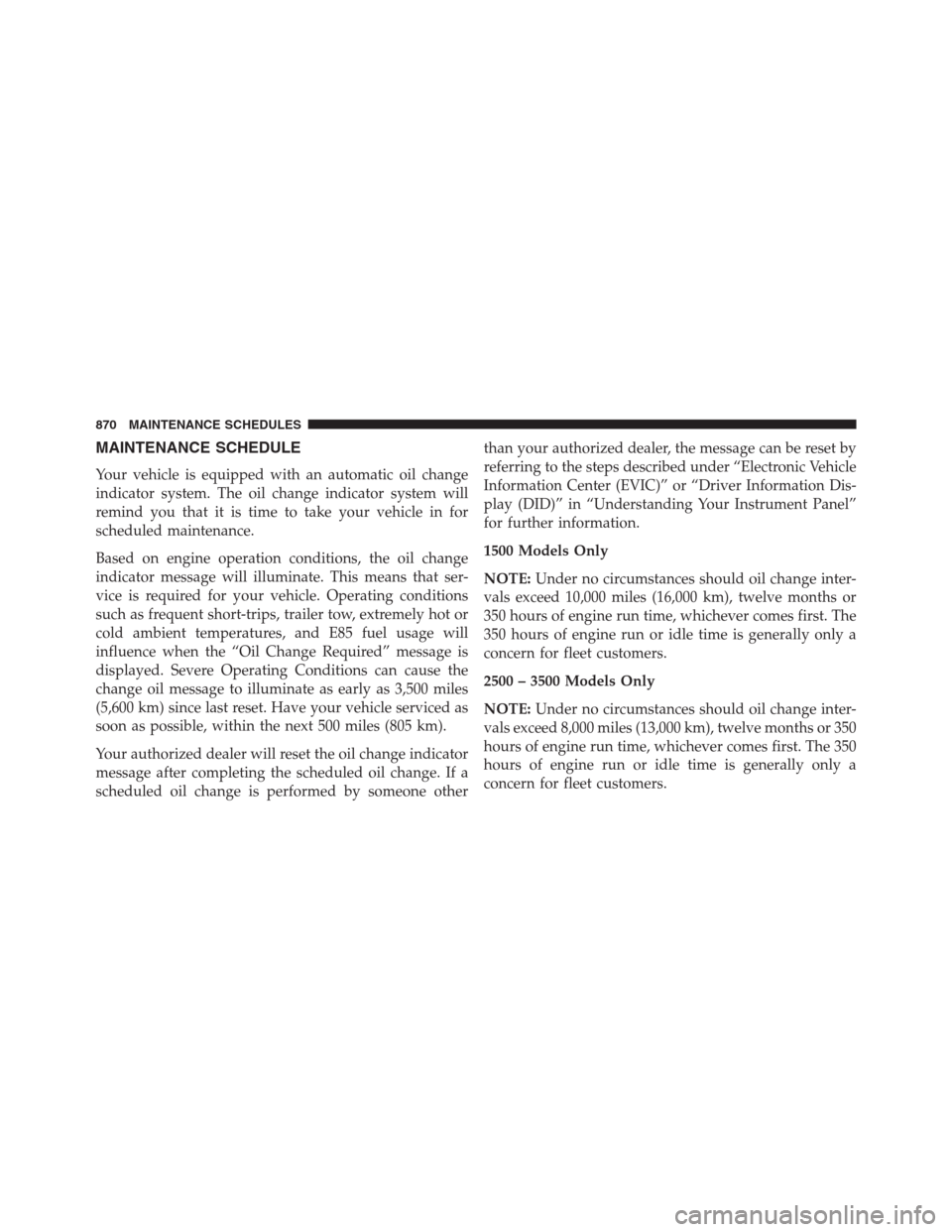
MAINTENANCE SCHEDULE
Your vehicle is equipped with an automatic oil change
indicator system. The oil change indicator system will
remind you that it is time to take your vehicle in for
scheduled maintenance.
Based on engine operation conditions, the oil change
indicator message will illuminate. This means that ser-
vice is required for your vehicle. Operating conditions
such as frequent short-trips, trailer tow, extremely hot or
cold ambient temperatures, and E85 fuel usage will
influence when the “Oil Change Required” message is
displayed. Severe Operating Conditions can cause the
change oil message to illuminate as early as 3,500 miles
(5,600 km) since last reset. Have your vehicle serviced as
soon as possible, within the next 500 miles (805 km).
Your authorized dealer will reset the oil change indicator
message after completing the scheduled oil change. If a
scheduled oil change is performed by someone otherthan your authorized dealer, the message can be reset by
referring to the steps described under “Electronic Vehicle
Information Center (EVIC)” or “Driver Information Dis-
play (DID)” in “Understanding Your Instrument Panel”
for further information.
1500 Models Only
NOTE:Under no circumstances should oil change inter-
vals exceed 10,000 miles (16,000 km), twelve months or
350 hours of engine run time, whichever comes first. The
350 hours of engine run or idle time is generally only a
concern for fleet customers.
2500 – 3500 Models Only
NOTE:Under no circumstances should oil change inter-
vals exceed 8,000 miles (13,000 km), twelve months or 350
hours of engine run time, whichever comes first. The 350
hours of engine run or idle time is generally only a
concern for fleet customers.
870 MAINTENANCE SCHEDULES
Page 904 of 916
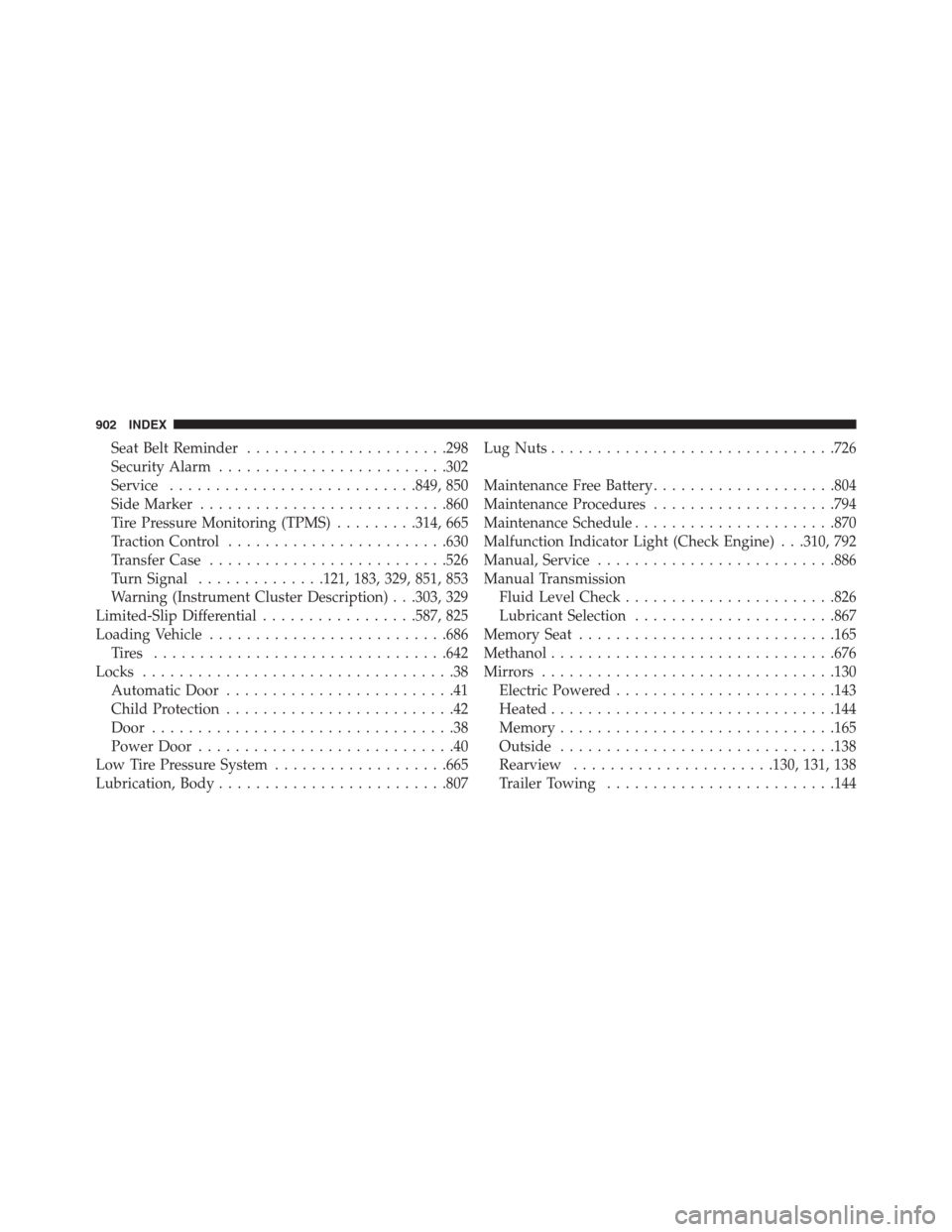
Seat Belt Reminder......................298
Security Alarm.........................302
Service...........................849, 850
Side Marker...........................860
Tire Pressure Monitoring (TPMS).........314, 665
Traction Control........................630
Transfer Case..........................526
Turn Signal..............121, 183, 329, 851, 853
Warning (Instrument Cluster Description) . . .303, 329
Limited-Slip Differential.................587, 825
Loading Vehicle..........................686
Tires ................................642
Locks..................................38
Automatic Door.........................41
Child Protection.........................42
Door.................................38
Power Door............................40
Low Tire Pressure System...................665
Lubrication, Body.........................807Lug Nuts...............................726
Maintenance Free Battery....................804
Maintenance Procedures....................794
Maintenance Schedule......................870
Malfunction Indicator Light (Check Engine) . . .310, 792
Manual, Service..........................886
Manual Transmission
Fluid Level Check.......................826
Lubricant Selection......................867
Memory Seat............................165
Methanol...............................676
Mirrors................................130
Electric Powered........................143
Heated...............................144
Memory..............................165
Outside..............................138
Rearview......................130, 131, 138
Trailer Towing.........................144
902 INDEX
Page 912 of 916

Trailer And Tongue Weight................697
Wiring...............................707
Trailer Towing Guide.......................697
Trailer Weight............................697
Transfer Case............................826
Electronically Shifted..............526, 533, 538
Fluid................................867
Transmission............................490
Automatic..................490, 499, 511, 826
Fluid................................867
Maintenance...........................826
Shifting..............................487
Transmitter Battery Service (Remote Keyless Entry) . .31
Transmitter Programming (Remote Keyless Entry) . . .25
Transmitter, Remote Keyless Entry (RKE).........25
Transporting Pets.........................116
Tread Wear Indicators......................656
Turn Signals...................183, 329, 851, 853Uconnect
Customer Programmable Features........391, 410
Operation.............................417
Uconnect Settings.......................379
Uconnect Settings....................391, 410
Uconnect 8.4A/8.4AN Voice Recognition
Additional Information...................467
Do Not Disturb........................466
General Information.....................467
Siri Eyes Free..........................466
Uconnect 8.4 Settings
Customer Programmable Features — Units.....401
Uconnect Settings
Customer Programmable Features......43, 388, 408
Passive Entry Programming..........43, 388, 408
Uconnect Settings....................388, 408
Uconnect Voice Command...................445
Uniform Tire Quality Grades.................887
910 INDEX